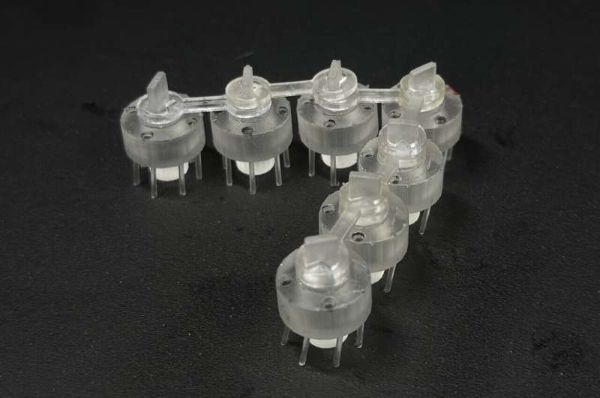Welcome to the latest swarm robot. It is called a link-bot. The technology comes out of a joint effort by researchers at Seoul National and Harvard universities. Link-bots are tiny robots that combine into V-shape-linked self-propelled units capable of exhibiting swarm behaviour. They can do complex tasks. They don’t require advanced programming. They don’t need artificial intelligence (AI) to move, explore, and coordinate their actions.
Their inventors have published in the journal ScienceAdvances. The article is entitled, “Emergent functional dynamics of link-bots.”
As I read it, I couldn’t help but think about Michael Crichton’s science fiction novel, “Prey,” a story that describes how a swarm of sentient, self-reproducing nanobots escape from a Nevada laboratory and begins a murderous assault on life in the desert and eventually their human creators.
Link-bots are not sentient, but they exhibit behaviours we normally associate with intelligence. They form V-shaped strands with the tiny bots working competitively or cooperatively. They can be used to move objects. They can be reconfigured and scaled.
The Rise of Swarm Robotics
Link-bots are swarm bots. Swarm bots take their inspiration from the collective behaviour of social insects like ants and bees. We even see cooperative behaviour in flocks of birds when they weave through the air with incredible synchronicity.
Robotic swarms involve individual machines working together to achieve common tasks where a single robot is insufficient. Engineers have taken the principles of living swarm intelligence to design these autonomous machines. What are their common characteristics?
- Decentralization: Control is shared rather than led by one robot, with each making decisions through interaction and information derived from neighbouring bots.
- Self-Organization: Complex behaviours emerge based on a set of rules that the individual robots enact within the swarm.
- Scalability: The swarm isn’t limited in size. It can perform its tasks equally well regardless of the number of robots within it.
- Robustness, fault-tolerance and built-in redundancy: Tasks can be completed even if individual robots within the swarm fail, with others in the group adapting and compensating.
- Flexibility: Swarms can adapt to the changing dynamics within an environment to complete assigned tasks.
Where are we seeing swarm robotics in action today?
- Military and Defence: The Russian-Ukraine war has witnessed both combatants adopting swarms of variable-sized Unmanned Aerial Vehicles (UAVs) instead of aircraft to do surveillance and attack targets. Often, hundreds are sent at a time, making it difficult for defenders to block all from reaching objectives.
- Agriculture: Swarms of aerial and ground-based robots are currently used to help monitor crops and execute precision farming activities such as irrigation, infestation detection, application of pesticides and herbicides, and even planting and harvesting.
- Environmental Monitoring: Swarms are being used to survey and collect data on air and water quality, monitor wildlife, track wildfires, and assess conditions in hard-to-reach and dangerous locations.
- Search and Rescue: Swarms are being deployed to do search and rescue missions such as air crashes in remote areas, looking for earthquake survivors in collapsed buildings, or mapping disaster sites for human rescuers.
- Manufacturing and Logistics: Swarms are used at warehousing and factory sites to help with material handling, do inventory management, and provide security.
Where will swarm robotics be deployed in the future besides all the areas mentioned above?
- Medicine: Nanobot-sized robot swarms may soon deliver drugs to targeted organs and sites within our bodies, or be used to assist in surgical procedures.
- Space Exploration: Swarms may accompany robotic spacecraft landers to be deployed for surface and scientific exploration and resource extraction.
What will be the impact of artificial intelligence (AI) and other coming technology advances on swarms?
- Enhanced Intelligence and Autonomy: Swarms like link-bots can already act in coordination without shared intelligence. With AI, we will have thinking swarms that are a lot smarter, capable of learning, more adaptive, able to achieve complex decision-making with self-correction, and fully autonomous.
- Hardware Miniaturization: The swarms being deployed in the Russia-Ukraine war are relatively large UAVs. The future will see swarms becoming much smaller, more energy-efficient, and cheaper to produce.
- Heterogeneity: Swarms today are homogeneous. All the individuals in the swarm are identical bots. Swarms in the future won’t be. They will combine multiple types of bots with different capabilities that will collaborate to achieve assignments. Imagine a future robot swarm consisting of flying, ground and water-based bots, some as big a current UAV, and others nano-sized.
- Human-Swarm Collaboration: Swarms will interact with humans for collaboration. Humans will use swarms to give them a virtual presence using augmented and virtual reality.
- Advanced Communication: High-bandwidth, low-latency communication will make swarm coordination more effective.
- Advanced Manufacturing: Swarm workers like ants and bees will be deployed to build things.
What are the risks of swarms turning into Crichton’s nanobots, and what can we do to ensure that the genie doesn’t get out of the bottle?
- Ethical Frameworks: As swarms become more capable and autonomous, regulations need to be put in place to be guardrails ensuring ethical behaviour.
- Security Frameworks: The decentralized nature of swarms and their reliance on communication make them vulnerable to various security threats, including data breaches and malicious takeovers. Swarms will need to be constrained by security measures to prevent their misuse by their human creators, by hijackers, or by themselves.
Link-bots are simple, active particles that form chain-like structures to carry out complex tasks. Future swarm bot members will be far more capable with full autonomy and onboard AI shared cooperatively. We will see creativity and adaptability that rival human ingenuity. Should we be scared?









